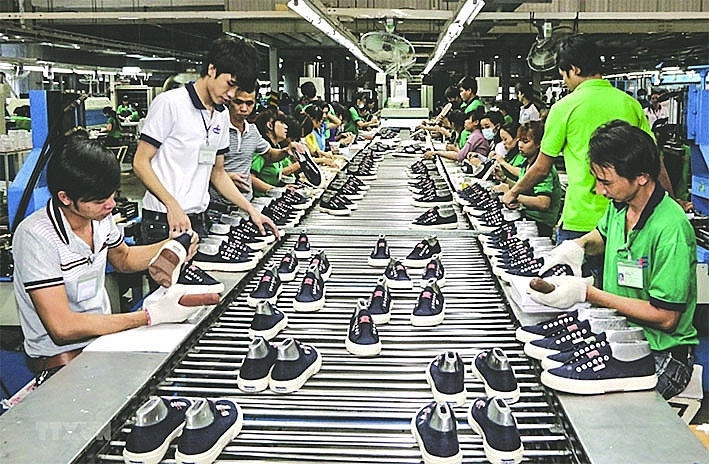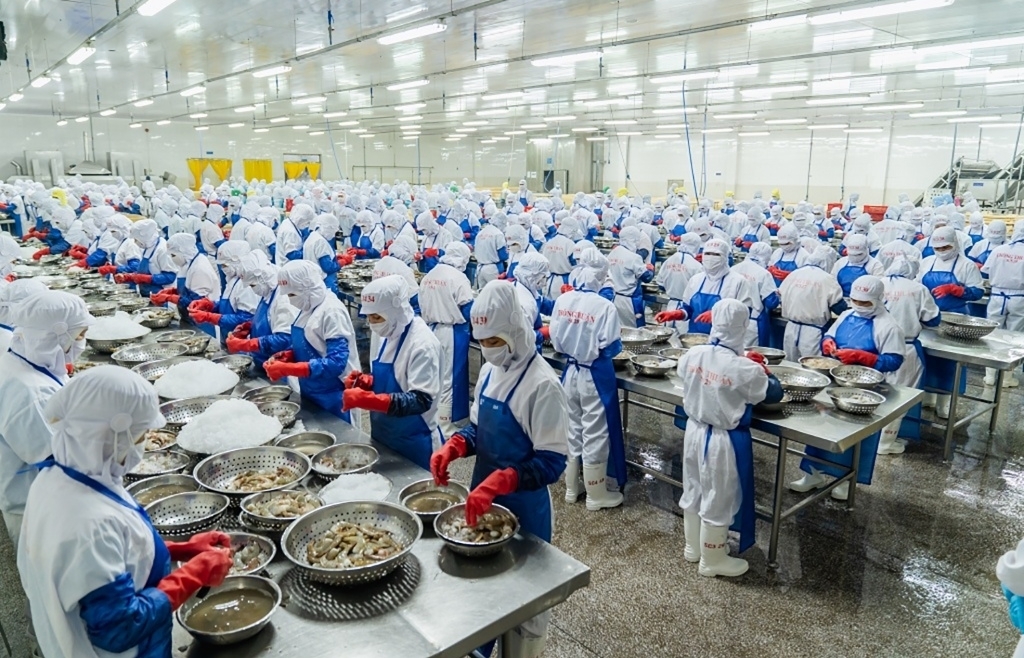Footwear will become Vietnam's next billion-dollar export item to Canada
| Footwear industry must implement green development to gain growth targets: Experts | |
| Dealing with outputs for the furniture, textile and footwear industries |
 |
| In order for the growth of turnover to be sustainable and to expand market share, Vietnamese enterprises need to switch towards building their own brands. Photo: Internet |
Ranked second in leather and footwear exports
Ms. Tran Thu Quynh, Trade Counselor, Vietnam Trade Office in Canada, said that Vietnam's exports of leather and footwear products to this market by the end of May 2023 reached USD 433 million. Meanwhile, Canada's total imports in this period were USD 1.14 billion, so Vietnam alone accounted for about 37% market share.
Currently, Canada's footwear import market is quite concentrated, with 10 main partners accounting for over 90% of the market share. Among the 10 largest exporting countries to the Canadian market, Vietnam's main competitors are Cambodia (enjoying GST) and Indonesia (which is about to sign the Comprehensive Economic Cooperation Agreement CEPA with Canada). India and Bangladesh have negligible market share and are decreasing year by year. Italy, Portugal, and Spain do not produce goods in the same segment as Vietnam. China is also gradually reducing the proportion of outsourcing for foreign brands, which mainly export to Canada fashion footwear, home shoes, beach shoes, and cheap sports shoes.
Notably, the size of the Canadian market for leather and footwear products is quite stable with an average annual import volume of over USD 3 billion. Currently, China is still the largest exporter to Canada, and Vietnam ranks second. The growth rate of Vietnam's leather and footwear turnover in the period 2018-2022 will reach 72%, helping Vietnam successfully capture more market share at the rate of 26.5% in 2022 (while China will decrease to 34.7%).
According to the Vietnam Trade Office in Canada, 5 years after the CPTPP, Vietnam's exports have nearly doubled to the market. “The growth rate of Vietnam's leather and footwear turnover and market share in Canada shows the positive effects of the agreement. With the growth rate recorded in the first months of 2023, it is entirely possible to think that leather and footwear will become the next billion-dollar export item of Vietnam to Canada," the Vietnam Trade Office in Canada expects.
However, a recent study by the Trade Office shows that although footwear is the item with the highest rate of preferential use of CPTPP (72%) compared to other Vietnamese products, it is estimated that there are over USD 230 million of Vietnam's exports are exported with the MFN tax rate of 5-20%, while we should be entitled to the CPTTP tax of 0%.
According to the Vietnam Trade Office in Canada, for some footwear products with the difference in tax rates between the MFN and the CPTPP, businesses have to pay an additional tax of 10 to 13.5%.
Quickly convert to build your own brand
In order to have a sustainable turnover growth rate and expand market share in Canada, according to Ms. Tran Thu Quynh, Vietnamese businesses need to transform in the direction of building their own brands. China is an example of a successful transition from outsourcing for multinational brands to specializing in the production of cheap, fashionable leather and footwear products for the world.
Analysis of competitors in the Canadian market in the same segment as China, Indonesia, India, and Bangladesh shows that Vietnam is quite weak in terms of the complete supply chain for the industry. India and Bangladesh have strengths in leather and synthetic materials. Indonesia also owns rubber, wood, and synthetic fibers in addition to footwear. These countries also have high-level dyeing, imitation leather, and tanning technology. Decorative stainless steel and alloy accessories are also available, helping to build new design and styling capabilities.
In other words, the strategy of increasing turnover based on processing orders and relying on the mid-market segment is not feasible because Vietnam does not have many competitive advantages. In the high-end segment, Canadian domestic manufacturers continue to hold a stable market share by holding market experience for specialty items (snow shoes, winter sports shoes, etc.) thanks to Canadians' awareness of supporting domestic brands.
Besides, in the high-end segment, it is difficult for Vietnam to surpass competitors such as Italy, Spain, Portugal, and Germany... because these are countries with a tradition of tanning and an auxiliary industry to make high-end items (key chains, zips, furs...).
Therefore, in order to produce Vietnam's own brand, it is necessary to target the low-middle-income segment of young people, which is still a potential niche market with a high-profit margin.
In addition, Vietnamese businesses need to actively participate in international fairs and exhibitions because this is both an opportunity to work directly with wholesalers to find outsourcing orders and an opportunity to expand its ability to participate in the segments of fashion footwear, handbags, beachwear, children's shoes, and home shoes...
“In addition, specialization in footwear, protective footwear, and industrial uniform shoes can also be taken into account (e.g. tunnel shoes, fire prevention shoes, woodworking shoes…) to have a market and prestigious private brands, avoid depending on outsourcing orders and the conditions of partners because Vietnam will soon no longer have the advantage in labor costs,” said the Vietnam Trade Office in Canada.
In addition, a matter of note for Vietnamese businesses is that Canadian consumers are very interested in certificates confirming the business's green, sustainable, and fair production process and products labeled Eco, certified materials, and recyclable products. Therefore, Vietnamese enterprises must actively standardize and innovate production processes, and at the same time need to prepare in the direction of automation, reducing labor content in production to improve competitiveness.
Related News
Latest News

VN's food processing industry struggles to improve quality and value chain integration
15:53 | 22/11/2024 Import-Export

Approach strategy of the seafood industry when implementing UKVFTA
09:26 | 22/11/2024 Import-Export

Mid-November: Vietnam's trade volume matches 2023 total, eyes record-breaking growth
09:25 | 22/11/2024 Import-Export

Vietnamese enterprises facing challenges from cross-border e-commerce platforms
14:32 | 21/11/2024 Import-Export
More News

Vietnam, Malaysia eye new milestone in trade ties
14:29 | 21/11/2024 Import-Export
Shrimp exports surge in 10 months, generating 3.2 billion USD
14:27 | 21/11/2024 Import-Export

Vietnam’s exports to the U.S. near US$100 billion milestone
09:46 | 21/11/2024 Import-Export

From the “abnormal” coffee price, worries about the new crop
09:46 | 21/11/2024 Import-Export

What obstacles limit the market share of Vietnamese goods in the UK?
14:49 | 20/11/2024 Import-Export

Why seafood exports to some Middle Eastern Countries are stalled
14:47 | 20/11/2024 Import-Export

Storm No. 3 destroys profits of many insurance companies
14:45 | 20/11/2024 Import-Export

Vietnam, Malaysia eye golden partnership opportunities in Halal industry
14:44 | 20/11/2024 Import-Export

Tra fish sector aiming for production, processing greening for sustainable development
14:41 | 20/11/2024 Import-Export
Your care

VN's food processing industry struggles to improve quality and value chain integration
15:53 | 22/11/2024 Import-Export

Approach strategy of the seafood industry when implementing UKVFTA
09:26 | 22/11/2024 Import-Export

Mid-November: Vietnam's trade volume matches 2023 total, eyes record-breaking growth
09:25 | 22/11/2024 Import-Export

Vietnamese enterprises facing challenges from cross-border e-commerce platforms
14:32 | 21/11/2024 Import-Export

Vietnam, Malaysia eye new milestone in trade ties
14:29 | 21/11/2024 Import-Export





